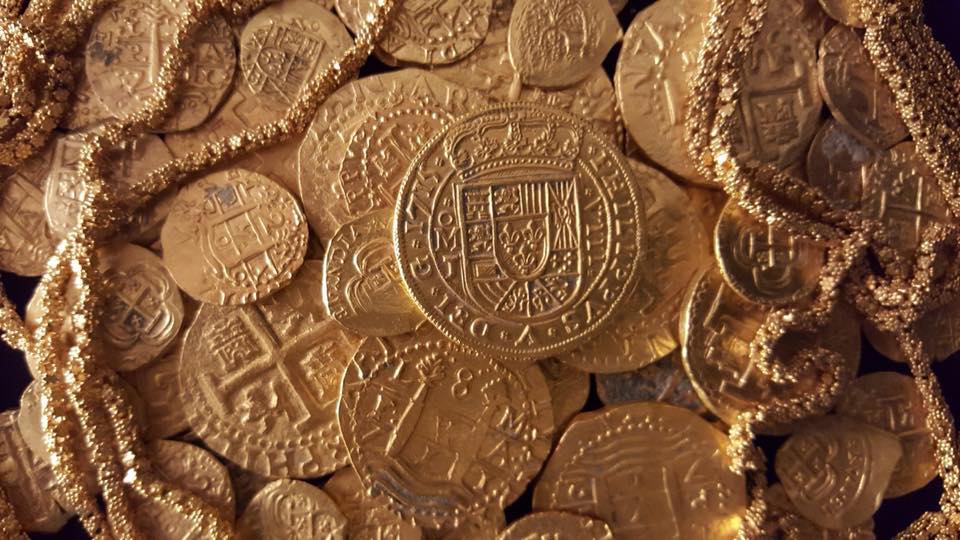Million-Dollar Find: Shipwreck's Golden Treasure Includes Very Rare Coin

Treasure hunters off the Florida coast recently pulled up the haul of a lifetime: nearly $1 million worth of gold coins and elaborate gold chains, as well as an extremely rare Spanish coin known as a "Tricentennial Royal."
The treasures were hidden on the seafloor for 300 years before the crew of a salvage vessel brought them to the surface last month, on June 17. The riches were found just 1,000 feet (305 meters) offshore of Fort Pierce, Florida, according to Eric Schmitt, captain of the aptly named salvage vessel, Aarrr Booty, which was used to locate the treasure.
The ships that once carried the valuables set sail from Cuba on July 24, 1715, when the island was a Spanish colony. The ships' mission was to transport the riches below deck to Spain, which at the time was waging a war against France and was desperately in need of money to fund battles. [Shipwrecks Gallery: Secrets of the Deep]
But the ships never made it to Spain. A hurricane off Florida sank all but one of the 12 ships on July 30, 1715. The so-called "1715 Fleet" has been a treasure-hunter's fantasy ever since. In 2010, Brent Brisben and his father, William, obtained permits to explore the wrecks in search of sunken riches.
The lucky haul off Fort Pierce was the work of the entire Schmitt family, which includes Eric and his wife, as well as Eric's sister and parents. The Schmitts were subcontracted to explore the 12 different shipwrecks for Brisben's company (1715 Fleet Queen Jewels, LLC), which owns salvage permits.
Included in Aarrr Booty's recent haul were 51 gold coins and 40 feet of golden chain. But the real treasure salvaged from the deep was the rare Tricentennial Royal, one of very few gold coins minted for King Philip V of Spain, according Schmitt, lead diver of the Aarrr Booty vessel's treasure-hunting expeditions.
The coin is "very round" compared to most coins salvaged from the wrecks, said Schmitt, who told Live Science that the royal coin was die-cast (made by pouring molten gold into a coin mold). Most Colonial coins from this period were made using cruder methods that resulted in less uniform shapes, according to the coin-collecting website Coinquest. The round royal coin, which is about the size of a silver dollar, is worth an estimated $500,000, according to Brent Brisben.
Sign up for the Live Science daily newsletter now
Get the world’s most fascinating discoveries delivered straight to your inbox.
And even though Brisben and Schmitt are excited about the discovery of this precious coin, both remain hopeful that even more treasure lies hidden off Florida. Brisben's company owns the salvage rights to five of the 11 ships that sank on July 30, 1715, he told Live Science. He estimates that $440 million worth of coins and other treasures have yet to be recovered from these centuries-old wrecks.
Among the treasures that are still at large are the elusive queens jewels, which belonged to Philip V's second wife, Elizabeth Farnese, Duchess of Parma. The elaborate jewels were to be a part of the queen's dowry and were supposed to be brought to Spain by the 1715 Fleet. Because jewelry wasn't a taxable commodity in Spain at the time, details about the jewels weren't entered on any official documents, but a few ornate items were allegedly aboard the fleet when it sank, including a 74-carat emerald ring and 14-carat pearl earrings, according to Brisben.
Follow Elizabeth Palermo @techEpalermo. Follow Live Science @livescience, Facebook & Google+. Original article on Live Science.

Elizabeth is a former Live Science associate editor and current director of audience development at the Chamber of Commerce. She graduated with a bachelor of arts degree from George Washington University. Elizabeth has traveled throughout the Americas, studying political systems and indigenous cultures and teaching English to students of all ages.










